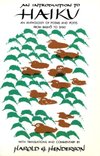Sublime
An inspiration engine for ideas
Basho wrote his haiku in the simplest type of Japanese speech, naturally avoiding literary and “highbrow” language, so creating a style which made it possible for ordinary people to be poets. Bankei, his contemporary, did just the same thing for Zen,
Alan W. Watts • The Way of Zen
In Japan, poems should not be tethered to the entanglement of a person’s ego. Humility, modesty, and a keen eye for small details in the natural environment are key attributes. As Basho said, “If you want to learn about the pine, then go to the pine, if you want to learn about the bamboo, then go to the bamboo. When you have become one with them,
... See moreAndrew Juniper • Wabi Sabi: The Japanese Art of Impermanence
The beauty of Basho’s prose, however, took the negative aspects of old age, loneliness, and death and imbued them with a serene sense of beauty.
Andrew Juniper • Wabi Sabi: The Japanese Art of Impermanence

The International Shakuhachi Society
komuso.com
Rinzai Roku (a celebrated Zen text of the T’ang dynasty) and the teachings of Bankei, the seventeenth-century Japanese master who, for me, represents Zen at its best.